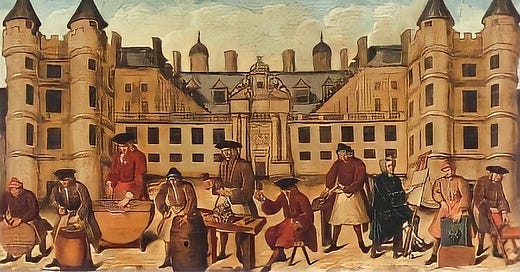Early Stonemasons of Scotland
What makes Scottish Freemasonry so unique is that historically Scottish Stonemasons and Scottish Freemasons were one and the same...
What makes Scottish Freemasonry different from that found around the world is its distinctive history, and that historically Scottish Stonemasons and Scottish Freemasons are one and the same.
Freemasonry in Scotland was not an artificial creation, it grew from the beliefs and institutions of working stonemasons and later individuals, like ourselves, who were allowed the privilege and honour of joining Stonemasons in their Lodges as they slowly began to admit men from other crafts and men of higher social status. Something that is extremely well documented thanks in part to the “Father of Freemasonry” William Schaw.
Stonemasons, like other trades in Scotland were part of an Incorporation. It’s purpose was to advance the interests of their members and had certain rights and responsibilities with regards the governance of the Craft, resolving trade differences, negotiating wages, supervising ‘quality control’, apprenticeship terms, burying deceased members, looking after their widows and orphans and even improving the morals of members. Similar to an English Trade Guild.
Unlike other incorporated trades such as Websters (weavers), Cordiners (shoemakers), Fleshers (butchers), Baxters (bakers), and Hammermen (metal workers), the essential difference between the craft of stonemasonry and these others was an additional level of organisation - the Lodge.
The reason for this was two-fold. Whereas the way of life of most craftsmen was a settled one, producing goods for sale locally or in distant markets via merchants; the stonemason’s trade was one that frequently moved around from job to job, a life of movement and unpredictability. This meant that the needs of a mason in terms of organisation and relations with his fellow craftsmen were rather different from those of most other locally based trades.
In addition to this, the Incorporation of Masons also included other trades such as Wrights (carpenters) and Coopers (barrel makers) and therefore did not facilitate the communicating of stonemasons’ secrets specific to their craft.
The painting above represents the ten crafts of the Wrights and Masons of the United Incorporations of Mary’s Chapel (not to be confused with the Lodge of St. Mary’s Chapel no.1) depicted working at their respective disciplines in front of Holyrood Palace in Edinburgh.
It was painted by artist Roderick Chalmers circa. 1720 and is actually a copy of an earlier painting believed to have been by the Dutch artist Jacob de Witt in the mid to late 1680s.
From left to right it shows sieve wright, slater, glazier, cooper, mason, wright, bowyer, painter, plumber, and upholsterer; with the two senior trades Mason and Wright occupying the central positions and seniority proceeding outward.
Chalmers’ version of the painting however has some interesting differences. For example each of the craftsmen are shown wearing seventeenth century workmen’s aprons over quite plain clothing as we assume it would have been in De Witt’s original. However, for the painter, Chalmers portrayed himself, elegantly posed with his legs crossed and sat on a high backed chair with the latest colourful fashions of the 1720s, white stockings and a powdered wig.
The painter is also the only craftsman not to be wearing seem form of hat or headgear, perhaps showing a changing of the times.

The mason, depicted left centre appears to be working on some decorative piece, perhaps to adorn the top of a column. Tradesmen’s accounts suggest that the Mason depicted by Chalmers is Robert Myln, who was “Master of mason-work” at Holyrood.
The painting belongs to the United Incorporations of Mary’s Chapel after being bought and gifted back to them by the Earl of Buchan and hangs in the home of the Convenery of the Trades of Edinburgh in Melville Street, Edinburgh.





